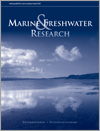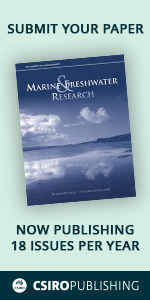Three genetic groups of Sepioteuthis spp. was identified in Japan and Taiwan. Sepioteuthis sp. 2 was dominant in Japan, whereas Sepioteuthis sp. 1 was dominant in Taiwan. Variations in life-history traits and statolith shapes of the squid were greater between geographic populations (Japan and Taiwan) than among the taxa. The results provide insights into the population structure and connectivity of Sepioteuthis spp. in the Northwest Pacific.

Marine and Freshwater Research
Volume 73 Number 8 2022
MF21103Age and growth of Pacific cownose ray, Rhinoptera steindachneri: a species with intermediate growth and shorter lifespan than expected
 , Felipe N. Melo-Barrera, Xchel A. Pérez-Palafox
, Felipe N. Melo-Barrera, Xchel A. Pérez-Palafox  , Andrés F. Navia
, Andrés F. Navia  , Víctor H. Cruz-Escalona
, Víctor H. Cruz-Escalona  and Paola A. Mejía-Falla
and Paola A. Mejía-Falla 
The age and growth of the Pacific cownose ray, Rhinoptera steindachneri, were examined in the south-western region of the Gulf of California, through edge type and marginal increment analysis of 276 vertebral centra. Individual growth was described using a multi-model approach and inference. Results indicated that R. steindachneri is a batoid species with intermediate growth and a shorter lifespan than for confamilial species and even than species with similar reproductive traits.
Black dogfish off Canada undergoes a multi-year distributional shift, starting in the Laurentian Channel pupping grounds–nursery area, then spreading out along slope waters, with the largest fish being found furthest from the Channel, up to 4000 km away. No other deep demersal species are known to have a dedicated nursing ground–pupping area or to undergo a progressive migration as they grow.
MF21326Abundance, distribution and behaviour of humpback whales (Megaptera novaeangliae) along the Pacific coast of Nicaragua, Central America
 , John Calambokidis, Etienne Pouplard, Victoria Pouey-Santalou, Carla Patulny
, John Calambokidis, Etienne Pouplard, Victoria Pouey-Santalou, Carla Patulny  , Bram Vanschoenwinkel, Marc Kochzius and Phillip Clapham
, Bram Vanschoenwinkel, Marc Kochzius and Phillip Clapham
This paper presents information on the distribution, behaviour, ecology and population size of humpback whales observed off the Pacific coast of Nicaragua. Thought to be part of the endangered humpback whale population off the Pacific coast of Central America, little is known about the population characteristics of the whales off Nicaragua. This knowledge will be valuable for scientists and decision makers to help establish effective conservation measures.
Tris(1,3-dichloro-2-propyl) phosphate (TDCIPP), as an organophosphorus flame retardant, prevails in the marine environment. This study shows that exposure to TDCIPP can adversely affect larval survival, larval growth, fecundity, and embryonic development in marine invertebrates. The results have implications for ecological risk assessment and management of organophosphorus flame retardants.
MF21141Vulnerability of 14 elasmobranchs to various fisheries in the southern Gulf of Mexico
 , Javier Tovar-Ávila
, Javier Tovar-Ávila  and Ana Minerva Arce-Ibarra
and Ana Minerva Arce-Ibarra 
Vulnerability of elasmobranchs to multiple fisheries was estimated through the productivity and susceptibility analysis (PSA) and rebound potential method. Among sharks and rays, the silky shark, sandbar shark and scalloped hammerhead, and southern stingray and spotted eagle ray had the highest vulnerability and the lowest rebound potential. In addition, significant correlations between rebound potential and the cumulative vulnerability of the approach that averaged susceptibility attributes were estimated, indicating a general pattern in which the species’ rebound potential increases while the vulnerability decreases.
MF22049Population dynamics and dietary habits of monkey goby (Neogobius fluviatilis) in its native range in the Dnieper River basin
 , Igor Buzevych, Yuriy Volikov, Alexander Gurbyk, Svitlana Kruzhylina and Vitaliy Bekh
, Igor Buzevych, Yuriy Volikov, Alexander Gurbyk, Svitlana Kruzhylina and Vitaliy Bekh
The population dynamics and dietary habits of monkey goby were studied in its native range in a freshwater habitat (Dnieper River). Altogether, 70 taxa of prey organisms composed the diet of this fish, among which the most abundant were chironomid larvae, followed by cladocerans. The opportunistic feeding strategy combined with time-expanded multiple spawnings and relatively fast growth can facilitate the successive invasion and establishment of this species in new environments, and contribute to its wide distribution.
MF21304Evidence of mitochondrial capture in Australian glass shrimp (Paratya australiensis) in south-eastern Queensland
Australian glass shrimp is widely distributed along the eastern coast of Australia. This shrimp is a species complex (nine species within one). We identified presence of two hidden species (cryptic species) when we used mitochondrial DNA but there was only one species when nuclear DNA was used.
MF21304 Abstract | MF21304 Full Text | MF21304PDF (1.2 MB) | MF21304Supplementary Material (492 KB) Open Access Article



